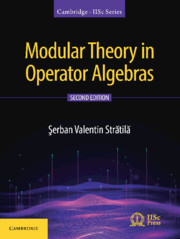Book contents
- Frontmatter
- Dedication
- Contents
- Preface to the Second Edition
- Preface to the First Edition
- Chapter I Normal Weights
- Chapter II Conditional Expectations and Operator-Valued Weights
- Chapter III Groups of Automorphisms
- Chapter IV Crossed Products
- Chapter V Continuous Decompositions
- Chapter VI Discrete Decompositions
- Appendix
- References
- Notation Index
- Subject Index
Preface to the First Edition
Published online by Cambridge University Press: 16 October 2020
- Frontmatter
- Dedication
- Contents
- Preface to the Second Edition
- Preface to the First Edition
- Chapter I Normal Weights
- Chapter II Conditional Expectations and Operator-Valued Weights
- Chapter III Groups of Automorphisms
- Chapter IV Crossed Products
- Chapter V Continuous Decompositions
- Chapter VI Discrete Decompositions
- Appendix
- References
- Notation Index
- Subject Index
Summary
The discovery of the modular operator and the modular automorphism group associated with a normal semifinite faithful weight has led to a powerful theory – the modular theory – which is nowadays essential to the consideration of many problems concerning operator algebras. This theory has been developed in close association with the effort to understand the structure and produce examples and refined classifications of factors. Thus, the crossed product construction, which gave rise to the first non-trivial examples of factors, has been shown to play a fundamental role in the structure theory as well, by reducing the study of the purely infinite algebras to the study of the more familiar semifinite algebras and their automorphisms. Moreover, several algebraic invariants, previously defined only in some special cases, have been introduced via the modular theory for arbitrary factors and the corresponding classification has been proved to be almost complete for approximately finite dimensional factors.
The present book is a unified exposition of the technical tools of the modular theory and of its applications to the structure and classification of factors. It is based on several works recently published in periodicals or just circulated as preprints. The main sources used in writing this book are the works of W. B. Arveson, A. Connes, U. Haagerup, M. Landstad, G. K. Pedersen, M. Takesaki, and J. Tomiyama. The general treatment of crossed products follows an article by Ş. Strătilă, D. Voiculescu and L. Zsidó. Due to the wealth and variety of results recently obtained, it has not been possible to include here a detailed exposition of the classification of injective factors and their automorphisms; these topics and several others are just mentioned in the Notes sections, together with appropriate references.
The reader is assumed to have a good knowledge of the general theory of von Neumann algebras, including the standard forms. Actually, the present book can be viewed as a sequel to a previous book, Ş. Strătilă and L. Zsidó – Lectures on von Neumann algebras, Editura Academiei & Abacus Press, 1979, which is often quoted here and referred to as [L]. There is also an Appendix which contains some supplementary results on positive self-adjoint operators and introduces the terminology connected with W*-algebras.
- Type
- Chapter
- Information
- Modular Theory in Operator Algebras , pp. xi - xiiPublisher: Cambridge University PressPrint publication year: 2020

